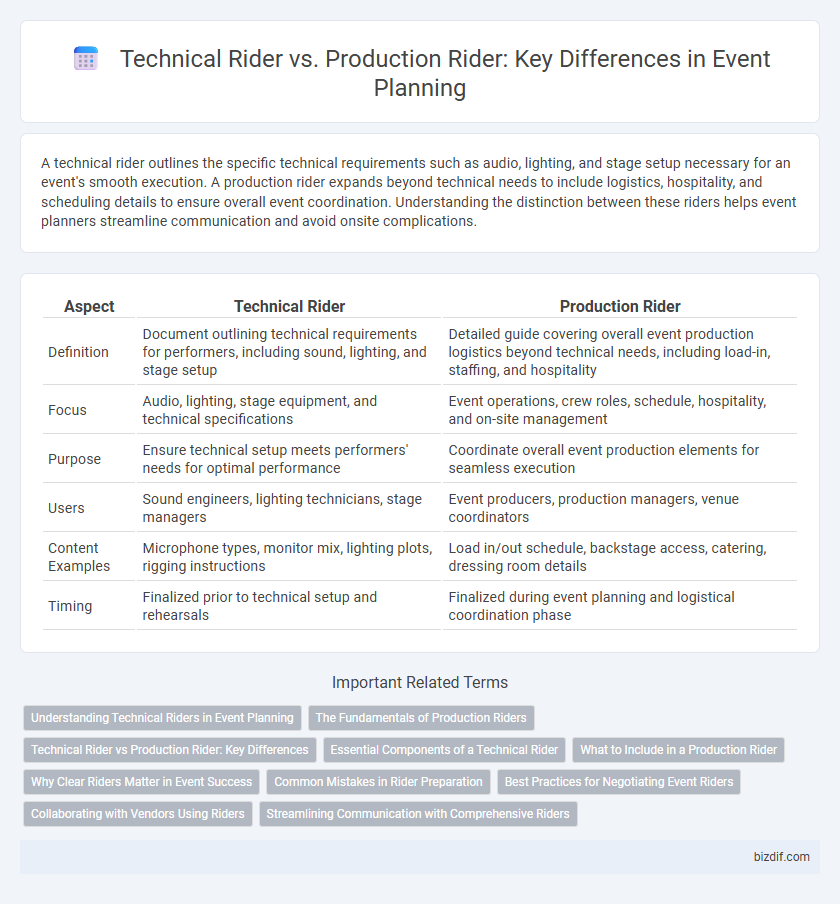A technical rider outlines the specific technical requirements such as audio, lighting, and stage setup necessary for an event's smooth execution. A production rider expands beyond technical needs to include logistics, hospitality, and scheduling details to ensure overall event coordination. Understanding the distinction between these riders helps event planners streamline communication and avoid onsite complications.
Table of Comparison
| Aspect | Technical Rider | Production Rider |
|---|---|---|
| Definition | Document outlining technical requirements for performers, including sound, lighting, and stage setup | Detailed guide covering overall event production logistics beyond technical needs, including load-in, staffing, and hospitality |
| Focus | Audio, lighting, stage equipment, and technical specifications | Event operations, crew roles, schedule, hospitality, and on-site management |
| Purpose | Ensure technical setup meets performers' needs for optimal performance | Coordinate overall event production elements for seamless execution |
| Users | Sound engineers, lighting technicians, stage managers | Event producers, production managers, venue coordinators |
| Content Examples | Microphone types, monitor mix, lighting plots, rigging instructions | Load in/out schedule, backstage access, catering, dressing room details |
| Timing | Finalized prior to technical setup and rehearsals | Finalized during event planning and logistical coordination phase |
Understanding Technical Riders in Event Planning
Technical riders outline specific equipment, technical requirements, and stage setup needed by performers for live events, ensuring seamless production flow. These documents detail sound systems, lighting specifications, and backstage arrangements critical for event planners to coordinate with technical crews. Understanding technical riders enables precise logistical preparation, minimizing on-site technical issues and enhancing overall event quality.
The Fundamentals of Production Riders
Production riders outline detailed technical and hospitality requirements agreed upon by the artist and event organizers to ensure seamless event execution. Unlike general technical riders that focus primarily on audio, lighting, and stage equipment specifications, production riders encompass broader logistics including stage management, load-in schedules, and safety protocols. Clear, comprehensive production riders help prevent miscommunication, allowing for efficient setup and smooth coordination among technical crews.
Technical Rider vs Production Rider: Key Differences
The Technical Rider outlines specific technical requirements such as sound, lighting, and stage setup necessary for a successful event, while the Production Rider encompasses broader logistical details including backstage accommodations, transportation, and meal provisions. The Technical Rider is primarily used by the event production team to ensure proper equipment and technical support are in place, whereas the Production Rider serves as a comprehensive guide covering all aspects of the artist's or event personnel's needs. Understanding these key differences is crucial for efficient event coordination and seamless execution.
Essential Components of a Technical Rider
A technical rider outlines essential components including detailed specifications for audio, lighting, stage setup, and video equipment required for a performance, ensuring all technical needs are met. It specifies power requirements, backline instruments, and any special effects or rigging necessary to execute the show professionally. Unlike the production rider, which covers broader logistical elements like load-in times and hospitality, the technical rider focuses exclusively on the technical infrastructure needed for flawless event execution.
What to Include in a Production Rider
A production rider should include detailed technical requirements such as stage dimensions, lighting specifications, sound system needs, and power requirements to ensure seamless event setup. It must outline logistics like load-in/load-out times, crew necessities, and backstage facilities to coordinate efficient production management. Including health and safety protocols and communication channels enhances event safety and operational clarity for all involved teams.
Why Clear Riders Matter in Event Success
Clear technical riders specify essential audio, lighting, and stage requirements, ensuring seamless equipment setup and preventing costly delays. Production riders detail logistical elements like artist accommodations and transportation, supporting smooth coordination between event stakeholders. Precise riders minimize misunderstandings, optimize resource allocation, and uphold event quality, directly impacting overall success.
Common Mistakes in Rider Preparation
Common mistakes in rider preparation often include confusing the technical rider with the production rider, leading to incomplete or inaccurate specifications. Technical riders should detail precise equipment, sound, lighting, and stage requirements, while production riders focus on logistics, scheduling, and hospitality needs. Overlooking these distinctions can cause miscommunication, delays, and increased costs during event execution.
Best Practices for Negotiating Event Riders
Technical riders detail specific equipment, staging, and technical requirements essential for event production, while production riders cover broader logistical aspects such as hospitality, security, and transportation. Best practices for negotiating event riders include thoroughly reviewing each rider's specifications, clarifying any ambiguous requests with the artist or production team, and establishing clear terms in the contract to avoid misunderstandings. Maintaining open communication ensures the event meets both technical standards and artist expectations, promoting a smooth production process.
Collaborating with Vendors Using Riders
Technical riders outline specific equipment, stage setup, and technical requirements essential for event execution, ensuring vendors align with the artist's or event's technical needs. Production riders complement this by detailing logistical elements such as catering, accommodations, transportation, and hospitality services to guarantee smooth vendor coordination. Effective collaboration with vendors using both riders streamlines communication, reduces misunderstandings, and enhances overall event quality by clearly defining expectations and responsibilities.
Streamlining Communication with Comprehensive Riders
Technical riders outline specific audio, lighting, and stage requirements essential for event execution, while production riders encompass broader logistical details including transportation, accommodation, and catering needs. Streamlining communication with comprehensive riders ensures all technical and production teams have clear, standardized instructions, minimizing misunderstandings and delays. Detailed riders contribute to seamless coordination, enhancing event efficiency and overall success.
Technical rider vs Production rider Infographic

 bizdif.com
bizdif.com